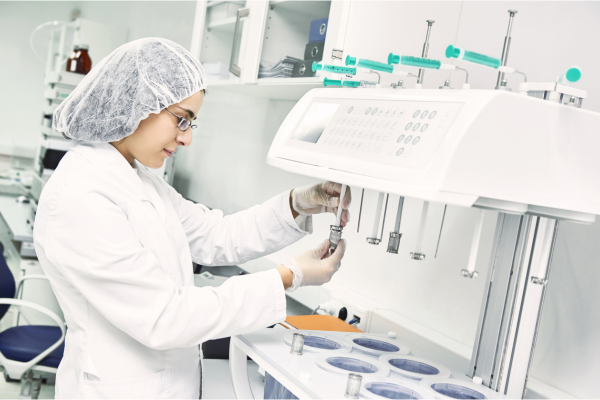Our sterile laboratory
To guarantee that the drug results are of the greatest quality and strictly adhere to the Australian regulations, all compounding requires clean and sterile atmosphere. This is essential while preparing and formulating sterile products. We can do both sterile aseptic and cytotoxic compounding at our cutting-edge facility’s controlled clean rooms, which includes the manufacturing of nasal inhalations, ocular drops and ointments, injections (IM, IV, or intrathecal), and other ophthalmic products.
Our clean rooms and preparation areas were constructed in accordance with NATA* certification and Australian ISO Class 7 standards. Proper temperatures, humidity, and pressure are always maintained, and the sterility and particulate counts are always at their ideal values throughout the whole facility.
Independent laboratories are utilised to test our compounded goods randomly on a regular basis to make sure they continue to be at the high levels necessary to comply with stringent Australian norms and requirements.

What is coumpounding? Is it Coumpoding legal?
There is a unique art and science behind compounding drugs. It is the compounder’s responsibility to prepare the compounded drug preparation a the proper dose of the Active Pharmaceutical Ingredirnt (API) and a appropriate quality and purity of all ingredients while maintaining sanitary, and if necessary, aseptic conditions while preparing a compounded drug preparation. The compounder must also provide the patients and their families with the proper instructions with clear labeling or face-to-face consultation. Although most pharmacies provide some level of compounding, the majority of compounding is done at pharmacies that have invested in the tools and training necessary to accomplish it effectively and safely.
These compounding pharmacies provide a variety of preparations, including sterile (often used for the eye or injection into body tissues or the blood) and non-sterile (ointments, creams, liquids, or capsules used in areas of the body where perfect sterility is not required) preparation. Basic compounding is a skill that all certified pharmacists must acquire and practise during their education and training. A mortar and pestle for grinding ingredients, graduated cylinders for measuring liquids, scales for weighing solids, spatulas for combining ingredients, and slabs of ointment to work on are other compounding instruments that are typically available at pharmacies. All pharmacists regularly make nonsterile compounded medications when prescribers request them using such tools and their knowledge.
Compounding does not include making copies of commercially available drug products, as this is not allowed by law. However, Compounding does not include making copies of commercially available drug products, as this is not allowed by law. Pharmacists engaged in compounding are expected to follow applicable standards and regulations for the types of preparations that are compounded.
What is coumpounding? Is it Coumpoding legal?
There is a unique art and science behind compounding drugs. It is the compounder’s responsibility to prepare the compounded drug preparation a the proper dose of the Active Pharmaceutical Ingredirnt (API) and a appropriate quality and purity of all ingredients while maintaining sanitary, and if necessary, aseptic conditions while preparing a compounded drug preparation. The compounder must also provide the patients and their families with the proper instructions with clear labeling or face-to-face consultation. Although most pharmacies provide some level of compounding, the majority of compounding is done at pharmacies that have invested in the tools and training necessary to accomplish it effectively and safely.
These compounding pharmacies provide a variety of preparations, including sterile (often used for the eye or injection into body tissues or the blood) and non-sterile (ointments, creams, liquids, or capsules used in areas of the body where perfect sterility is not required) preparation. Basic compounding is a skill that all certified pharmacists must acquire and practise during their education and training. A mortar and pestle for grinding ingredients, graduated cylinders for measuring liquids, scales for weighing solids, spatulas for combining ingredients, and slabs of ointment to work on are other compounding instruments that are typically available at pharmacies. All pharmacists regularly make nonsterile compounded medications when prescribers request them using such tools and their knowledge.
Compounding does not include making copies of commercially available drug products, as this is not allowed by law. However, Compounding does not include making copies of commercially available drug products, as this is not allowed by law. Pharmacists engaged in compounding are expected to follow applicable standards and regulations for the types of preparations that are compounded.
